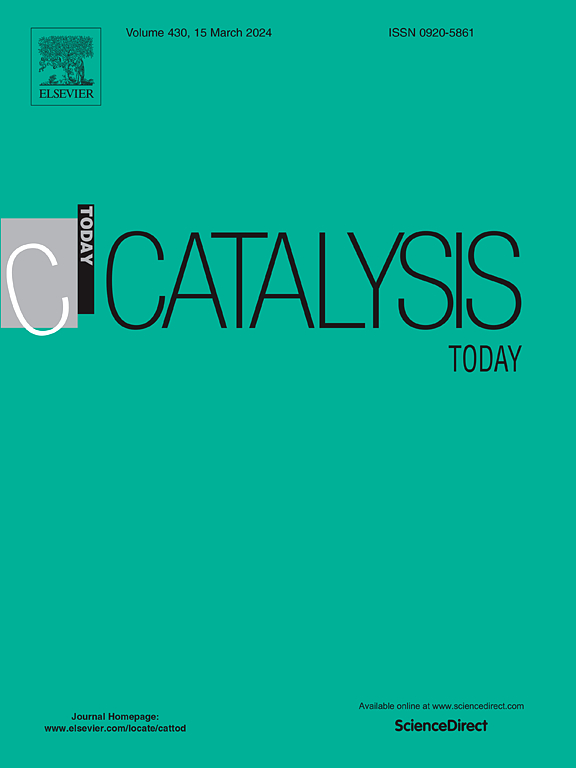甲烷环境下机器学习辅助生物油脱氧:愈创木酚模型化合物研究
IF 5.2
2区 化学
Q1 CHEMISTRY, APPLIED
引用次数: 0
摘要
基于前人的研究成果,甲烷辅助生物油脱氧的新方法具有广阔的应用前景。本研究选择愈创木酚作为模型化合物,进一步筛选催化剂,以达到最佳性能,实现无氢脱氧,同时提高有价BTX(苯、甲苯、二甲苯)的收率。利用机器学习模型对多金属掺杂ZSM-5催化剂进行了预测,并制作出符合要求的催化剂。在合理设计和制备催化剂的过程中,考虑了载体材料与负载金属之间的协同作用。选择ZSM-5作为支撑材料,以达到适当的酸度来触发愈创木酚的转化,同时对目标产物:苯、甲苯和二甲苯(BTX)保持良好的选择性。在低温条件下,通过Zn和Ga的共镀来提高甲烷的活性,并进一步引入Ce来防止甲烷的过度焦化。采用间歇式反应器进行反应性能研究,以了解反应的转化率、焦炭收率、期望产物的选择性等。优化后的Zn-Ga-Ce/ZSM-5催化剂的愈创木酚转化率为58 wt%, BTX选择性高达90%。通过NH3-TPD、DRIFTS、XRD、TEM、BET、TGA等综合表征,深入了解催化剂的理化性质。研究了催化剂的理化性质与反应性能的关系。该研究将为甲烷辅助转化的催化剂工程提供启示。本文章由计算机程序翻译,如有差异,请以英文原文为准。
Machine learning assisted bio-oil deoxygenation under methane environment: The model compound study on guaiacol
The novel approach of methane-assisted deoxygenation on bio-oil is highly promising based on our previous studies. In this study, guaiacol was chosen as the model compound to further screen the catalyst to achieve optimal performances aiming to realize hydrogen-free deoxygenation while enhancing the yield of valuable BTX (benzene, toluene, and xylene). A catalyst of multi-metals doped ZSM-5 was predicted using machine learning model and fabricated to meet the requirements. Additionally, the synergistic effect between the support material and the loading metals were taking into account during the rational design and fabrication process of the catalyst. ZSM-5 was chosen as the support material to achieve a proper acidity to trigger the conversion of guaiacol while maintaining excellent selectivity towards the target products: benzene, toluene, and xylene (BTX). Zn and Ga was co-coped to enhance the methane activation at low temperatures, while Ce was further introduced to prohibit the over coking. A batch mode reactor was applied in the reaction performance studies aiming to understand the conversion, coke yield, selectivity of desired products, etc. The optimized Zn-Ga-Ce/ZSM-5 catalyst showed a conversion of guaiacol with the liquid yield of 58 wt% and BTX selectivity of as high as 90 %. Comprehensive characterizations including NH3-TPD, DRIFTS, XRD, TEM, BET, and TGA were conducted to gain in-depth understanding on the physicochemical properties of the catalyst. The relationship between the reaction performance and physicochemical properties of the catalyst has been explored carefully. This study will shed light on the catalyst engineering for the methane-assisted conversions.
求助全文
通过发布文献求助,成功后即可免费获取论文全文。
去求助
来源期刊

Catalysis Today
化学-工程:化工
CiteScore
11.50
自引率
3.80%
发文量
573
审稿时长
2.9 months
期刊介绍:
Catalysis Today focuses on the rapid publication of original invited papers devoted to currently important topics in catalysis and related subjects. The journal only publishes special issues (Proposing a Catalysis Today Special Issue), each of which is supervised by Guest Editors who recruit individual papers and oversee the peer review process. Catalysis Today offers researchers in the field of catalysis in-depth overviews of topical issues.
Both fundamental and applied aspects of catalysis are covered. Subjects such as catalysis of immobilized organometallic and biocatalytic systems are welcome. Subjects related to catalysis such as experimental techniques, adsorption, process technology, synthesis, in situ characterization, computational, theoretical modeling, imaging and others are included if there is a clear relationship to catalysis.
 求助内容:
求助内容: 应助结果提醒方式:
应助结果提醒方式:


